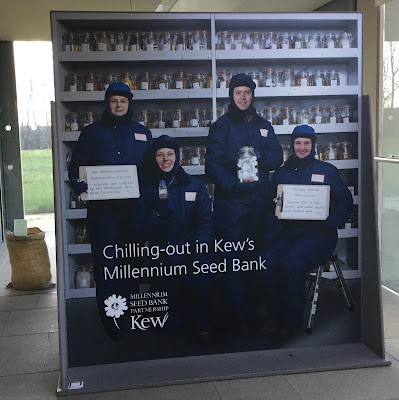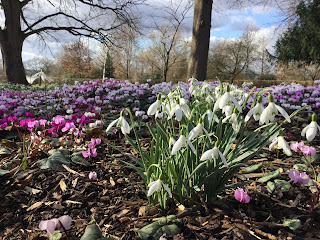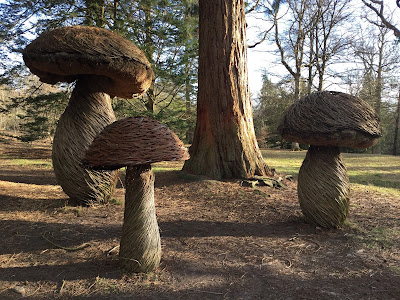Man has had a close relationship with Nature throughout time. The passage from winter into spring has always been a special time. It is commemorated in spring festivals throughout the world. The first rays of spring sunshine and flowers bring smiles to faces even in dense cities.
I was lucky to spend a bright sunny day at Wakehurst Place recently. Wakehurst Place is home to Kew's Millennium Seed Bank. Its conservation work and scientific research should help to ensure that Man's special connection to Nature continues for centuries to come. (The Vimeo video of my walk appears at the end of this blog).
A huge seed artwork greets you at the entrance to Wakehurst Place. Kew's Millennium Seed Bank is a world leader in plant conservation. It aims to bank 25% of the world's seeds by 2020.
 |
| Displays inside the Millennium Seed Bank |
I discovered some interesting videos, displays and figures about this important conservation work inside the building. As of 1st February 2017, the seed bank's staff have banked a total of:
- 2,200,964,170 seeds
- From 81,533 seed collections
- Representing 37,614 different species
- From 189 different countries
Contractors were working on an extension to the vault space underneath the Millennium Seed Bank on the day of my visit. This extension will provide sufficient storage space for collections beyond 2020. There were students from Imperial College London and BSix College, as well as colleagues from Denmark, New Zealand, Belgium and Germany.
Staff and volunteers were working on cleaning seed collections from Azerbaijan during my visit. You could see into the labs through the glass viewing panes. The Millennium Seed Bank is truly an international effort.
 |
| Seeds come in all shapes, colours and sizes |
Storage Process
I read a lot about how staff ensure optimum storage conditions for the seeds. Seeds are dried to reduce their moisture content and slow biological processes. The technique helps to avoid deterioration in storage at very low temperatures. Some seeds can last for hundreds of years if stored in this way.
Staff have to be very careful when working in the vaults. They have to work quickly and wear protective suits. -20°C with a wind chill of around -27°C may be good for seed storage, but these are not good temperatures for human survival.
 |
| Staff wear protective suits inside the freezing seed vaults |
Troublesome Seeds
The Seed Bank's research into how to store recalcitrant seeds is particularly interesting. Some species die if their moisture content drops below 40%. Coffee and avocado are two of the troublesome plants.
 |
| Recalcitrant Cocoa (left); a range of orthodox seeds (right) |
The Great Green Wall
The Millennium Seed Bank is also sharing its expertise in seed collecting and the best propagation techniques with the world. The Great Green Wall initiatives in the Sahel and Sahara are helping to stabilise grass and tree roots to combat desertification. There are also pilot projects in other parts of Africa. The ambitious plan is to create a great green wall of plants and trees spreading across 13 countries.
Pressed Flowers
 |
| Pressed poppies on display |
My interest probably started with making daisy chains on my grandmother's lawn. My fascination with plants really took off after a cliff-walking holiday in Guernsey. The wild flowers were glorious there.
My parents bought me a Collins Guide to Wild Flowers. I identified an amazing range of common and rare species in the local woods, hills and fields. I was lucky to live in an Area of Outstanding Natural Beauty in Somerset. I never did discover the rare Cheddar Pink (Dianthus gratianopolitanus). It only grows on the limestone rocks in a few places in the Mendip Hills and Cheddar Gorge.
Woodland Walk
After my tour of the Millennium Seed Bank's displays and different plant beds outside, I set off on a walk around Wakehurst Place's grounds. I followed a trail through Bethlehem Wood with some amazing exposed tree roots.
 |
| Walk through Bethlehem Wood |
I discovered some black sheep in a field by Horsebridge Wood. I continued onward past some huge 'mushrooms' among Californian Redwoods until I was greeted at Westwood Lake by some noisy ducks.
 |
| Hillside full of spring crocuses |
My favourite section of the walk was near the pond. You see the brightly-coloured winter stems of dogwoods and box leading to a hillside carpet of snowdrops and crocuses. It was a very tranquil spot with the sound of the running stream and occasional bird song.
I discovered a verse of New England poetry at the top of the hill:
Give fools their gold, and knaves their power;
Let fortune's bubbles rise and fall;
Who sows a field, or trains a flower,
Or plants a tree, is more than all.
The perfect verse for a wonderful spring day. A very fitting poem for Wakehurst Place as it takes great pains to ensure that the world's seeds will be passed on to future generations.
Below you will find a Vimeo video of my walk through Wakehurst Place:
Spring 2017 Visit to Wakehurst Place from Karen Andrews on Vimeo.
Karen Andrews is a freelance French to English translator, transcreator, content writer and editor. She has a strong background in global marketing.
Email Karen for further information via karenanglicityen@gmail.com in French, German or English.




No comments:
Post a Comment